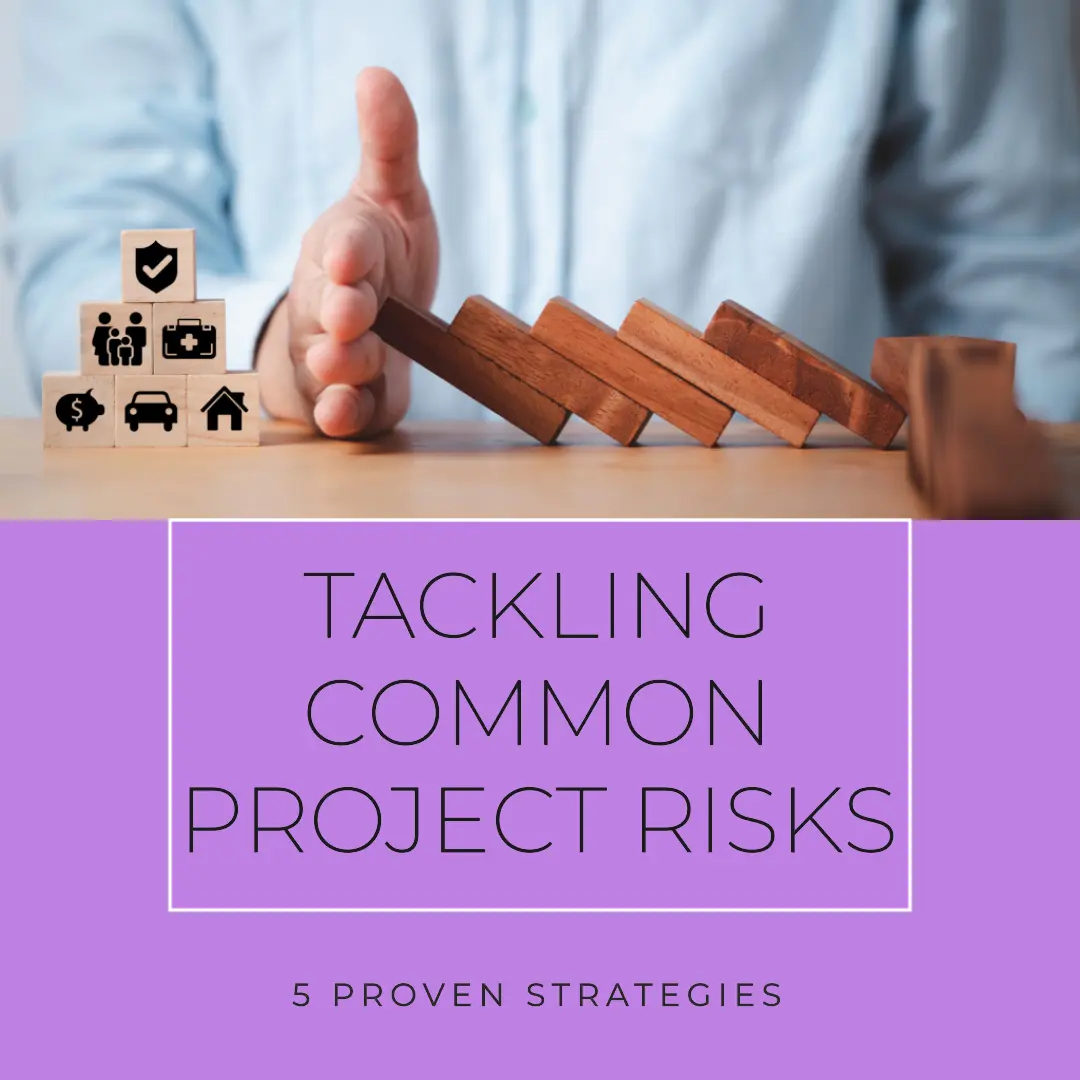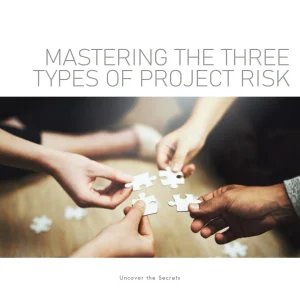I. Introduction
Hey there, fellow project managers and risk-tackling enthusiasts! If you’ve ever managed a project, you know how important it is to be prepared for potential obstacles along the way. After all, no project is without its share of risks, and it’s our job to ensure that we navigate these challenges as smoothly as possible.
You might have encountered common project risks before, such as budget overruns, scope creep, or unexpected changes in team dynamics. These risks can jeopardize the success of your project, and that’s exactly why we’re here today. In this blog post, I’ll be sharing with you five proven strategies to tackle common project risks, so you can confidently face these hurdles and enhance your project’s chances of success.
By the end of this article, you’ll have a solid understanding of how to identify, prioritize, and manage risks effectively. So, buckle up and get ready to arm yourself with the knowledge and tools you’ll need to become a risk management superhero!
II. Strategy 1: Conduct Thorough Risk Assessments
A solid foundation is key to any successful project, and that’s where thorough risk assessments come into play. Remember, you can’t manage what you don’t know. So, it’s crucial to dive deep into the potential pitfalls that could throw your project off course.
A. Explain the risk assessment process
Begin by brainstorming all the possible risks your project may face. Involve your team members in this process, as they often bring diverse perspectives and unique insights to the table. Once you’ve compiled a list, it’s time to assess each risk based on its likelihood of occurrence and potential impact on the project.
B. Discuss the importance of identifying and prioritizing risks
I cannot stress enough how essential it is to prioritize risks. In an ideal world, we’d have unlimited time and resources to address every single risk. But let’s face it, we all have constraints. By focusing on the risks that pose the highest threat to your project, you’ll be better equipped to allocate your resources effectively and minimize any adverse effects.
C. Offer tips for effective risk assessments
Here are some quick tips to help you conduct a successful risk assessment:
- Be objective and realistic when assessing risks. Avoid underestimating or overestimating their potential impact.
- Utilize risk assessment tools and techniques, such as risk matrices, SWOT analysis, or expert interviews, to support your process.
- Revisit your risk assessment regularly, as risks can evolve throughout the project lifecycle. Keep an eye out for new risks that may emerge as the project progresses.
Now that you have a solid grasp on risk assessments, let’s move on to the next step – developing a comprehensive risk response plan!
III. Strategy 2: Develop a Comprehensive Risk Response Plan
You’ve identified and prioritized your project risks – great job! But what now? It’s time to develop a solid plan to address those pesky risks that are keeping you up at night. A comprehensive risk response plan is your project’s safety net, guiding your team’s actions when risks materialize.
A. Define risk response planning
Risk response planning is the process of determining the most appropriate course of action to manage and mitigate each identified risk. This involves assigning responsibility to team members and outlining specific steps to be taken to either prevent the risk from occurring or minimize its impact.
B. Explain the four common risk response strategies: avoid, transfer, mitigate, and accept
Here are the four most common risk response strategies:
- Avoid: When possible, take actions to eliminate the risk entirely. This might involve modifying the project plan, scope, or schedule.
- Transfer: Sometimes, it’s better to shift the risk to another party, such as an insurance provider or subcontractor. This doesn’t eliminate the risk, but it can help you manage the potential impact.
- Mitigate: If you can’t avoid or transfer the risk, consider taking steps to reduce its likelihood or impact. This could involve implementing additional quality controls, increasing communication, or providing additional training for your team.
- Accept: In some cases, risks are simply unavoidable or too small to warrant any action. In these instances, it’s essential to acknowledge the risk and be prepared to deal with its consequences should it occur.
C. Offer guidelines for creating a risk response plan
Keep these guidelines in mind as you create your risk response plan:
- Assign clear ownership of each risk to a team member or stakeholder who is responsible for implementing the response strategy.
- Develop a detailed action plan for each risk, outlining the necessary steps, resources, and deadlines.
- Communicate the risk response plan to all relevant parties, ensuring everyone is on the same page and understands their role in managing risks.
- Monitor the effectiveness of your risk response strategies and make adjustments as needed.
With a solid risk response plan in place, you’re one step closer to conquering those common project risks! Let’s continue on our risk management journey with our next strategy: implementing strong communication channels.
IV. Strategy 3: Implement Strong Communication Channels
In the world of risk management, communication is king. It’s the glue that holds everything together and ensures everyone is on the same page when it comes to addressing project risks. When communication falters, so does your ability to manage risks effectively.
A. Discuss the role of communication in risk management
Effective communication allows you to keep your team informed about the risks they’re responsible for, the progress of risk mitigation efforts, and any changes in risk status. It also fosters a culture of open dialogue, where team members feel comfortable sharing concerns or identifying new risks that may emerge.
B. Explain the importance of transparency and openness
Transparency and openness are key ingredients for successful risk management. By creating an environment where team members can openly discuss risks without fear of backlash, you’ll encourage a proactive approach to risk management, with everyone playing their part in spotting and addressing potential issues.
C. Offer tips for establishing effective communication channels within the project team and with stakeholders
Here are some tips to help you establish strong communication channels for risk management:
- Develop a communication plan: Outline the who, what, when, and how of risk-related communication. Clearly define roles and responsibilities, and establish a schedule for regular risk updates.
- Utilize multiple communication methods: Mix up your communication tools to suit your team’s preferences and project needs. Consider using team meetings, email updates, instant messaging, or collaboration platforms like Slack or Trello.
- Encourage open dialogue: Foster a culture where team members feel comfortable raising concerns, sharing updates, or discussing potential risks. This can be achieved through regular check-ins, open-door policies, or even anonymous feedback channels.
- Keep stakeholders in the loop: Don’t forget to keep stakeholders informed about project risks and mitigation efforts. Transparent communication can help build trust and ensure stakeholders understand the steps you’re taking to manage risks effectively.
Now that you’ve mastered the art of communication in risk management, it’s time to delve into our next strategy: establishing a contingency plan.
V. Strategy 4: Establish a Contingency Plan
You’ve got your risk assessments, response plans, and communication channels in place – but what if things still go awry? That’s where contingency plans come in. These are your backup plans, designed to help you navigate unexpected twists and turns when risks materialize.
A. Define contingency planning
Contingency planning is the process of preparing for unexpected events or risks by outlining alternative courses of action to follow if your initial risk response strategies don’t pan out. Think of it as a “Plan B” that provides a safety net for your project when risks become a reality.
B. Discuss the importance of having backup plans for high-impact risks
While it’s impossible to predict every potential issue that could arise during a project, having a contingency plan in place for high-impact risks can be a lifesaver. It ensures that you’re not caught off guard and enables you to respond quickly and effectively when faced with unforeseen challenges.
C. Offer guidelines for creating a contingency plan
Keep these guidelines in mind as you create your contingency plan:
- Focus on high-impact risks: Concentrate on developing contingency plans for risks that could significantly disrupt your project or jeopardize its success.
- Be specific: Outline the exact steps your team should take if a risk materializes, including who is responsible for each action and any necessary resources or support.
- Consider financial implications: Budget for contingencies by setting aside funds to cover potential extra costs that could arise from the materialization of high-impact risks.
- Review and update your contingency plan: Just like your risk assessment and response plan, your contingency plan should be a living document that’s regularly reviewed and updated to reflect changes in the project or risk landscape.
With a solid contingency plan in place, you’re better prepared to handle any curveballs that come your way. But we’re not done yet! Let’s move on to our final strategy for tackling common project risks: monitoring and reviewing risks regularly.
VI. Strategy 5: Monitor and Review Project Risks Regularly
Risk management isn’t a one-and-done process. It’s an ongoing effort that requires continuous vigilance and adaptability. By regularly monitoring and reviewing your project risks, you’ll ensure that you’re always ready to tackle any challenges head-on.
A. Explain the need for ongoing risk monitoring and review
Project environments are ever-evolving, with new risks emerging and existing risks changing in likelihood and impact. Regularly reviewing your risks ensures that you’re aware of any shifts in the risk landscape and can respond accordingly to keep your project on track.
B. Discuss the benefits of regular risk review meetings
Regular risk review meetings provide an opportunity for your team to come together, share updates on risk mitigation efforts, and discuss any new risks that may have emerged. These meetings help to maintain a proactive risk management culture, promote transparency, and ensure that everyone stays informed and engaged in the process.
C. Offer tips for effective risk monitoring and review
Here are some tips to help you effectively monitor and review your project risks:
- Schedule regular risk review meetings: Set a consistent schedule for risk review meetings, such as monthly or quarterly, to ensure that risks are continually assessed and addressed.
- Establish clear meeting objectives: Outline the goals and expectations for each risk review meeting, including reviewing the status of existing risks, discussing new risks, and evaluating the effectiveness of risk response strategies.
- Encourage active participation: Foster an environment where all team members feel comfortable sharing updates, concerns, or ideas related to risk management.
- Update your risk register: Following each risk review meeting, update your risk register to reflect any changes in risk status, mitigation efforts, or contingency plans.
As you implement these strategies, you’ll find yourself well-equipped to tackle common project risks and enhance your project’s chances of success. So, go forth, and conquer those risks with confidence!
VII. Conclusion
Well, there you have it! We’ve journeyed together through the five proven strategies for tackling common project risks, arming you with the knowledge and tools you need to become a risk management powerhouse. Let’s quickly recap what we’ve learned:
- Conduct thorough risk assessments to identify and prioritize potential risks.
- Develop a comprehensive risk response plan to address and mitigate risks effectively.
- Implement strong communication channels to foster transparency and a proactive risk management culture.
- Establish a contingency plan to serve as your project’s safety net when risks materialize.
- Monitor and review project risks regularly to stay ahead of the curve and keep your project on track.
By incorporating these strategies into your project management toolkit, you’ll be better prepared to navigate the uncertainties that come with any project, ensuring your project’s success and your team’s peace of mind. So, here’s to your future risk management triumphs – may you face every challenge head-on and emerge victorious!
Now, it’s time to put these strategies into action and show those common project risks who’s boss! Good luck, and happy risk-tackling!
To find out how Artificial Intelligence is changing the Project Management landscape, you have enjoy reading this article https://www.shaunstoltz.com/did-artificial-intelligence-just-change-everything-about-project-management/
Find out more about Shaun Stoltz https://www.shaunstoltz.com/about/
This post was written by an AI and reviewed/edited by a human.



